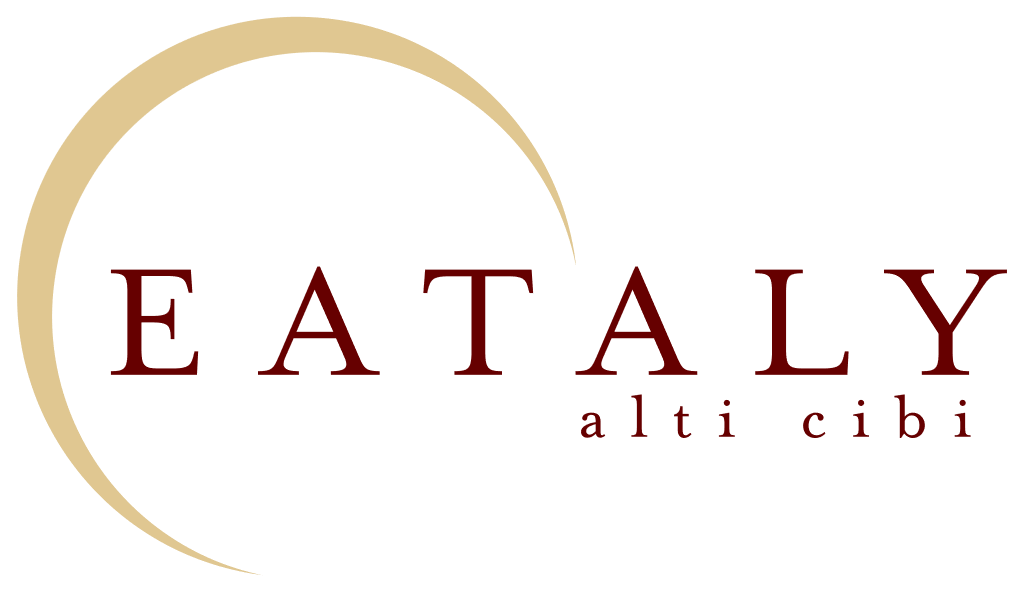By making us aware of how important our own name is and what image it throws on us within society, it becomes clearer to us how important the naming of a product or service that is newly launched on the market is should be, really is. For a new product as well as for start-ups, naming is the first step in the world of communication. And as the saying goes: You don’t get a second chance to make a good first impression.
What are the characteristics of good names?
- You have an identity, a character, a personality.
- They are easy to pronounce and often short.
- They are very symbolic: they evoke stories, feelings, emotions.
- They are specific but not explanatory: they convey a clear idea but are never simple descriptions.
Let’s look at a few examples, some of which perfectly meet all of the above guiding principles, but some also have different properties:
Eataly: A mixture of the English word for the verb “eat” and the country Italy (“Italy”), the meets all the required properties. The name has an identity, it sounds good, is symbolic and specific, without describing the project in more detail.
Quattro Salti in Padella: the name of a successful food brand. It’s so musical it could be a nursery rhyme too. And for this reason, it is successful despite its length.
IBM: Abbreviation for International Business Machines. Creating names from acronyms requires special care these days. The reasons for this can be found in the following section.

How to create effective names
In today’s world of abundance of products and services, a memorable name that sounds appealing and interesting is more important than ever. If you are busy with naming for your next product, here are some tips for you:
1. Analyze the direct environment
If you search, you will usually find it. Before you start writing down your ideas, take a look at your competitors. Carefully evaluate the names that the competition is using in your industry and write down the most interesting, original and the product names that attract the most attention.
2. Link, associate and recombine
After you’ve got an idea of the names of your competition, the real creative phase begins. At first it can be helpful to look for associations: How do you think the name Eataly came about? The area of food (from which the English verb eat) was associated with the “Italianity” (and the associated term Italy ). This link works particularly well because it is memorable, easy to pronounce and also sounds similar to Italy.
3. Take your linguistic freedom (but in moderation)

Language offers a lot of space for experimentation, for creating neologisms and for word games. But complete freedom without any rules can confuse the senses and cause blockages. For this very reason, some guidelines can be helpful:
Exchange, add or omit letters
You can change the letters in a word, add new ones or leave out letters to create original and evocative neologisms. I personally recommend making just one of these changes to the initial term. An example of this would be the blog Pennamontata , since the “a” in “pannamontata” (Italian for “whipped cream”) has been replaced by an “e”.
The joining and mixing of two words is a very successful technique. But if you use this method, as was done by the Italian airline Alitalia (“ali” (wing) + “Italia” (Italy)), you should pay particular attention to the sound of the result. This technique works particularly well when the last part of the first word coincides with the beginning of the second word. Another example of this is Pinterest, made up of “pin” and “interest”, which the segment “in” have in common – a really successful combination.
4. It doesn’t necessarily have to be neologisms
Sometimes the ideal name already exists as a word in a field that we may not have thought of when we were looking for ideas. In other words, one can also speak in metaphors. To do this, we have to learn to ask about the how of certain product features and let our mind wander into distant worlds that at first glance have nothing to do with our product. Is this glass really that strong? How strong? Like a gorilla? And there’s it: Gorilla Glass . And the same goes for Yoga as a name for a laptop whose screen is much more flexible than that of the average laptop.
5. Acronyms: Walked through the door, returned through the browser window

Acronyms or abbreviations – like IBM – work these days not so well anymore. They are neither direct nor evocative and actually always need to be explained. So they embody the exact opposite of all properties that are important in the age of the digital revolution. However, there are a few exceptions that work:
• You can create acronyms whose end result makes full or at least partial sense. If it then evokes a certain idea, the goal is fulfilled. An example: the Museum of Modern Art in Bologna is called Mambo, short for Museo di Arte Moderna di Bologna. A successful name with character and effect.
• In some cases, acronyms also offer the opportunity to invent new words that are still free and available as a website domain – a factor that is of fundamental importance for success in our world today.
6. The perception beyond meaning
Words have sounds, shapes, colors, temperatures. The M communicates hospitality, the A calm, the O completeness. The I is colder than the E. Consonants like the R and T communicate a feeling of harshness, which is why you shouldn’t use them in abundance in a name that is supposed to convey a feeling of security and gentleness. Did you also know that many people see the vowels in certain colors ( synesthesia )?
7. Names develop from names
You can find the right name by thinking about several. Better ten names too many than too few, because every noted name can result in more. Write downloads of names while you are busy with other things. You have to let yourself go, arouse associations, encourage the subconscious to participate in the creative process. It should be fun. They’ll be sorted out later, but we have to invent them first.
8. Between naming and website domain: The Ikea case
For companies that rely on a digital presence, it is almost essential that their name and website domain match one hundred percent. Because this makes it much easier to be found by potential users or customers. As a direct consequence of this necessity, the process of naming becomes much more difficult: While before the digital age it was sufficient that a name was not yet used by another company in the same or a similar industry, one must now also ensure that the web domain is still used is available, which makes the whole process a little more complicated.
But the digitization of Naming also affects the creative aspect of this work. On the one hand, the need to find a free domain makes it more difficult to come up with a name with high symbolic value; on the other hand, there is a certain tendency towards more and more self-explanatory and descriptive names that one would not have even considered until a few years ago. The idea behind this is that the name should at least partially correspond to a keyword used by the user.
In each of these names, the descriptive component clearly dominates over the evocative and emotional. But while we lose meaningfulness on one side, we secure traffic on the other, thanks to the keywords that already correspond to real search queries.
But also this tendency, which brings with it the risk that the end result is shiny loses can be converted to a great benefit of one’s own. The names of the Ikea product classics have been renamed in a humorous way based on the real search terms of the users. For example, a sofa on the side is called My partner is snoring, an abacus was Share the costs with my partner and a note board is named He can’t tell me he loves me.
This campaign was a great success in terms of empathy with its customers: the company empathizes with the people it communicates in a personable and funny way and makes it clear that it is not just a piece of furniture, but a part of ours lives, which consists of small and large truths from everyday life – a really great inspiration.
The naming, again in a nutshell
The most important rule is probably this: There are no rules, only guidelines. For example, we’ve seen that IBM-style abbreviations no longer work, but only in theory. The shorter the better, but nobody forgets “Quattro salti in padella” anytime soon. Strongly explanatory names sound cool and banal and yet the case of Ikea shows us that you can also drive successfully on this track.
We hope that this article has helped you and wish you every success with your next Naming project.

